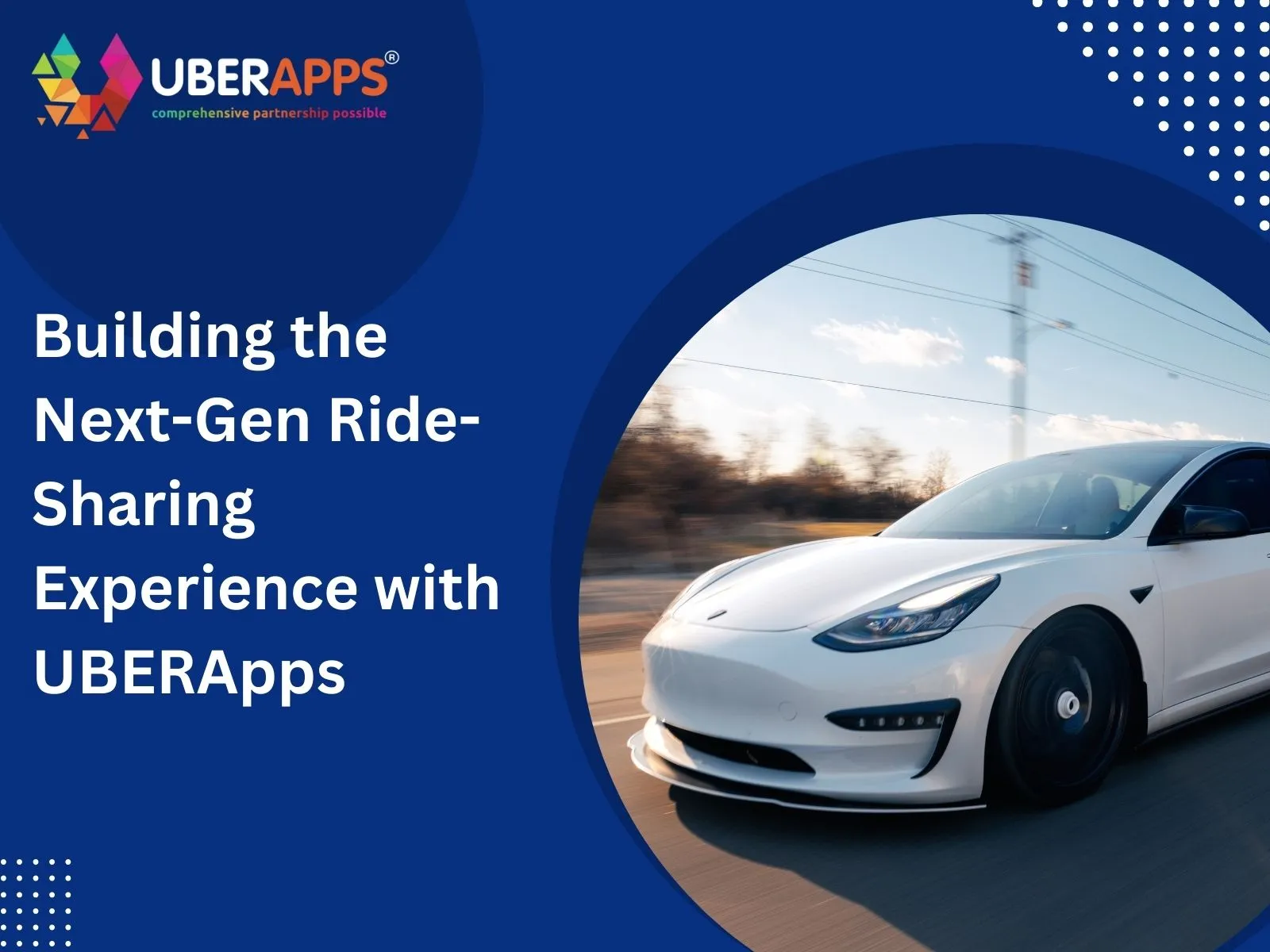
Building the Next-Gen Ride-Sharing Experience with UBERApps
The ride-sharing industry has undergone a massive transformation over the past decade, shifting from traditional taxis to app-based services that provide convenience and affordability. As a pioneer in this revolution, UBER has consistently pushed the boundaries of technology and customer experience. With the introduction of UBERApps, the company is setting the stage for the next generation of ride-sharing services. This advanced platform is designed to leverage cutting-edge technology to enhance user convenience, safety, and sustainability.
In this blog, we'll explore how UBERApps is redefining the ride-sharing experience and what it means for both riders and drivers.
UBERApps Technologies has revolutionized the ride-sharing industry by integrating advanced technologies like AI, real-time data analytics, and cloud computing. Traditional taxi services offer personalized ride recommendations, seamless payments, and enhanced safety features. Its commitment to sustainability is evident through support for electric vehicles and smart routing to reduce carbon emissions. The platform's focus on rider convenience and driver well-being sets a new standard for urban mobility. As we continue to innovate, it is well-positioned to lead the next generation of ride-sharing services with efficiency, safety, and environmental consciousness.
The Evolution of Ride-Sharing Services
The journey of ride-sharing started with the need to bridge the gap between riders and available vehicles seamlessly. Traditional taxis had limitations such as limited availability, unclear pricing, and often inconvenient booking methods. The advent of UBER changed this narrative by introducing a mobile-first approach that connected riders to drivers through a simple app.
However, as the market matured, challenges like surge pricing, safety concerns, and driver dissatisfaction became apparent. UBERApps is an ambitious attempt to address these pain points by utilizing AI, real-time data analytics, and personalized experiences. This evolution not only simplifies the ride-booking process but also ensures a safer, more efficient journey for all.
Key features of UBERApps include
- AI and Machine Learning: For personalized ride suggestions and dynamic pricing.
- Cloud Computing: Ensures data is processed and available in real time.
- Data Analytics: This helps us understand rider preferences and improve our services accordingly.
By harnessing these technologies, We not only improve user experience but also ensure operational efficiency and scalability.
1The Technology Behind UBERApps
At the heart of UBERApps is a sophisticated tech stack that includes AI, machine learning, cloud computing, and big data analytics. AI is used extensively for predictive modeling from forecasting ride demand to optimizing routes in real-time. Meanwhile, cloud infrastructure ensures that data processing and communication between drivers and riders are instant and reliable.
Key technological components include
- AI and Machine Learning: For personalized ride suggestions and dynamic pricing.
- Cloud Computing: Ensures data is processed and available in real time.
- Data Analytics: This helps us understand rider preferences and improve our services accordingly.
By harnessing these technologies, We not only improve user experience but also ensure operational efficiency and scalability.
2 Enhancing User Experience with UBERApps
User experience is at the core of UBERApps' strategy. Personalized ride recommendations based on past behavior, preferences for music and temperature, and even preferred routes make every journey comfortable. Additionally, the platform's ability to integrate different modes of transport ensures that riders have multiple options to reach their destination efficiently.
Key Enhancements Include
- Personalized Recommendations: AI suggests rides based on past behavior.
- Advanced Route Optimization: Minimizes travel time and fuel consumption.
- Seamless Payments: Supports e-wallets, credit cards, and cryptocurrency
These features, combined with enhanced safety protocols such as live tracking and emergency assistance, ensure that riders feel secure and valued throughout their journey.
3 The Driver-Centric Approach
While we enhance the rider experience, it also significantly improves the driver's side of things. AI-driven features such as optimal ride matching reduce idle time for drivers, while flexible payment options and incentive programs help maximize their earnings.
Driver Benefits
- Safety Enhancements: AI-based monitoring and alerts for drivers.
- Flexible Earnings: Real-time tracking of earnings and incentives.
- Support and Training: AI-driven training modules for better service.
By focusing on the well-being and earnings of drivers, UBERApps aims to build a more sustainable and motivated driver community.
4Integration of Autonomous Vehicles
The future of ride-sharing is autonomous, and UBERApps is paving the way for this transition. By integrating self-driving technology, UBERApps aims to reduce costs and improve safety. However, challenges such as regulatory compliance and public trust must be addressed.
Steps Towards Autonomy
- Testing and Safety Protocols: Ensures autonomous vehicles are safe.
- Regulatory Compliance: Working with authorities to set standards.
- Mixed Fleet Strategy: Gradual integration with human drivers.
This balanced approach allows UBERApps to introduce autonomous rides without disrupting the ecosystem.
4Sustainability and Green Initiatives
With increasing focus on sustainability, UBERApps emphasizes electric vehicles (EVs) and green ride options. Incentives for EV drivers, partnerships with EV manufacturers, and AI-driven route optimization contribute to reducing the carbon footprint.
Sustainability Efforts
- EV Incentives: Reduced commission rates for EV drivers.
- Carbon Offset Programs: Invests in environmental projects.
- Smart Routing: Minimizes fuel consumption and emissions.
These initiatives not only enhance UBER's brand image but also appeal to environmentally-conscious users.
Conclusion
In an era where convenience, safety, and sustainability are paramount, UBERApps SaaS-based taxi apps has emerged as a trailblazer in the ride-sharing industry. By harnessing the power of artificial intelligence, real-time data analytics, and seamless integration of multi-modal transport options, UBERApps is redefining urban mobility for both riders and drivers. Its commitment to a driver-centric approach, enhanced safety features, and green initiatives showcase a holistic vision beyond just connecting people with rides. It's about shaping the future of transportation.
The integration of advanced technologies such as AI-driven predictive modeling, autonomous vehicles, and cloud-based infrastructure not only improves efficiency but also ensures a highly personalized experience for users. Meanwhile, the emphasis on electric taxis and carbon reduction aligns UBERApps with the growing demand for eco-friendly solutions, setting a new benchmark for sustainability in the ride-sharing market.
As UBERApps continues to innovate, it is well-positioned to lead the next generation of ride-sharing services. Its ability to adapt to evolving consumer needs, address regulatory challenges, and maintain high standards of data security and privacy ensures that both riders and drivers can look forward to a safer, more reliable, and environmentally conscious ride-sharing experience. The journey of UBERApps is just beginning, and its impact on the global transportation landscape is poised to be profound and lasting.
FAQS
1. What makes UBERApps different from the traditional UBER app?
UBERApps integrates AI-driven personalization, real-time data analytics, and multi-modal transport options
2. How does UBERApps enhance safety for both drivers and riders?
AI-driven monitoring, emergency response features, and live tracking significantly enhance safety.
3. Will UBERApps support electric vehicles and green initiatives?
Yes, UBERApps offers incentives for EV drivers and focuses on sustainability.
4. How does UBERApps' pricing work?
UBERApps use dynamic pricing based on demand and supply, ensuring fair compensation for drivers.
5. How does UBERApps handle data privacy and security?
Advanced encryption and compliance with global privacy regulations ensure data security.
Author's Bio

Vinay Jain is the Founder of UBERApps and brings over 10 years of entrepreneurial experience. His focus revolves around software & business development and customer satisfaction.

